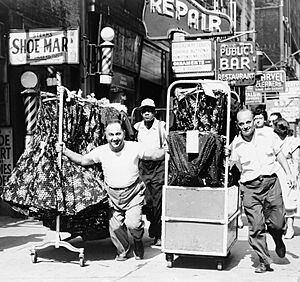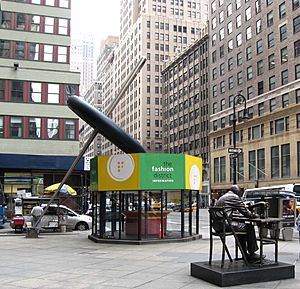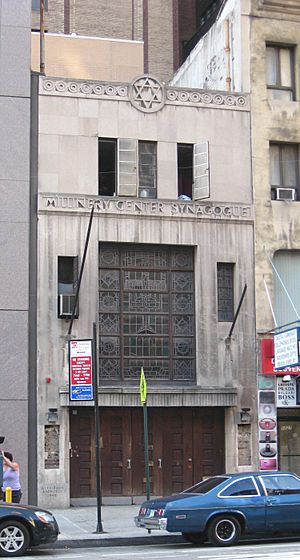Garment District, Manhattan facts for kids
The Garment District, also known as the Fashion District, is a neighborhood in Manhattan, New York City. It's famous for making and selling clothes. This area is called the Garment District because many fashion businesses are located there. It covers less than 1 square mile (2.6 km²). The district is usually found between Fifth Avenue and Ninth Avenue, from 34th Street to 42nd Street.
This neighborhood has many fashion showrooms and offices for big fashion brands. It handles every step of the fashion process. This includes designing clothes, making them, and selling them wholesale. Since the early 1900s, the Garment District has been the main place for fashion design and manufacturing in the United States. Being close to this area helps fashion companies in America succeed.
Contents
Where is the Garment District?
By the late 1930s, the Garment District was mostly surrounded by Sixth Avenue to the east and 42nd Street to the north. It also reached Ninth Avenue to the west and 25th Street to the south. A part of it, between 25th and 30th Streets, was known as the Fur District. It worked in a very similar way.
Today, the Garment District is generally west of Fifth Avenue and south of 42nd Street. It goes as far south as the mid-20s streets. The Fashion Institute of Technology is also in this area. The fashion industry used to be strongest between 28th and 38th Streets. Its heart was Seventh Avenue, which was even called "Fashion Avenue" in 1972. As the clothing industry has changed, the district has become smaller. By 2004, it was mostly between Fifth and Ninth Avenues and 35th and 41st Streets.
The Garment District's Fashion Role
New York City is a top "global fashion city." In 2011, it made $9 billion in sales. The main part of this industry is Manhattan's Garment District. Most major fashion brands have showrooms here. They do everything from designing clothes to selling them wholesale. No other city has so many fashion businesses and talented people in one place.
The Garment District is home to many famous designers. It also has their factories, warehouses, showrooms, and fabric suppliers. Many people in the industry say that this close group of businesses works like an ecosystem. Each part helps the whole fashion community. Big fashion brands like Carolina Herrera, Oscar de la Renta, and Calvin Klein have offices or showrooms here.
In the past, the Garment District was known for making textiles. But global changes have affected how the fashion industry works here. Over the last 50 years, clothing manufacturing in New York has decreased. This happened because rents in Manhattan are high. Also, local factories found it harder to compete globally. Many companies started making clothes in other countries where it was cheaper.
The Garment District began to shrink as manufacturing in the city declined. In 1987, New York City tried to protect garment manufacturing. They created a special zoning rule for the area. This rule limited other types of businesses to keep rents low for factories. However, this rule did not stop manufacturing from declining. The future of the district is still being discussed by leaders and fashion experts.
History of the Garment District
Early Beginnings in the 1800s
New York City first became important for making clothes by producing clothing for workers on large farms in the Southern United States. It was easier for farm owners to buy clothes from New York City than to have their workers make them. Tailors in New York also made ready-made clothes for sailors and gold prospectors when they weren't busy with their usual work.
Before the mid-1700s, most Americans made their own clothes. Wealthy people would have clothes custom-made by a tailor. But by the 1820s, more ready-made clothes were being produced. These clothes were better quality and sold to more people. The invention of the sewing machine in the 1850s helped turn clothing production into a true industry. The need for thousands of uniforms during the American Civil War also helped the clothing industry grow a lot.
Before 1840, women were the main workers in the clothing industry. But by 1880, men took over most of the skilled jobs. This was because many Jewish men from Poland and Russia moved to America. Many of them were tailors who learned to use machines. German and Central European immigrants also came to America in the mid-1800s. They had business skills just as clothing making was becoming more advanced. In the early 1900s, many Eastern European immigrants worked in the garment factories. These immigrants helped create American fashion.
It was hard to organize workers into unions at first because they came from many different countries. Before 1880, most garment workers were not interested in unions. However, as more Eastern European Jews joined the industry, union membership grew among them.
New York City had many workers and a good way to deliver clothes. So, it was ready to meet the demand for clothing. By the late 1860s, most Americans bought their clothes instead of making them. In the 1870s, the value of clothes made in New York grew six times larger. By 1880, New York made more clothes than its four closest city rivals combined. Two out of every five ready-to-wear clothes were made in New York City. In 1900, the clothing business was three times larger than the city's second biggest industry, which was sugar refining.
The 1900s and Today
In 1909, making clothes for women and men was a leading industry in New York City. New York's role as a fashion center also helped the clothing industry. It constantly offered new styles, creating new demand. In 1910, 70% of the nation's women's clothing and 40% of the men's clothing was made in New York City.
However, cheaper labor and production overseas have greatly affected New York's industry for many years. This change has forced many designers to move their production overseas. This has also affected small cutting and sewing shops, as well as stores selling zippers, buttons, and other supplies in the Garment District. Some city officials worry that if manufacturing disappears, many designers will leave. This could hurt New York's reputation as a fashion capital like Paris or Milan. The fashion industry's two big events, Fashion Week, bring many visitors and create millions of dollars for the city.
The Garment District Alliance is a group that works to keep the area busy. They promote the Garment District for fashion and other businesses. For example, they created a Fashion Walk of Fame on 7th Avenue. They also organize Arts Festivals and have an information kiosk. This kiosk helps fashion professionals, students, and visitors find what they need.
The "Save the Garment Center" campaign was started by fashion industry members. They want to keep fashion businesses in the district. But as clothing manufacturing declines, many buildings that once held factories are now offices. Businesses like accountants, lawyers, and tech companies have moved in. Now, the area is split evenly between fashion and non-fashion companies.
Getting Around the Garment District
The Garment District is easy to reach by public transport. It's close to Penn Station, which serves New Jersey Transit, Amtrak, and the Long Island Rail Road. It's also near Grand Central Terminal, which serves the Metro-North Railroad.
You can also use the New York City Subway. There are stations at 34th Street–Herald Square, 34th Street–Seventh Avenue, and 34th Street–Eighth Avenue. Other nearby stations include Times Square–42nd Street/Port Authority Bus Terminal and 42nd Street–Bryant Park/Fifth Avenue. The Port Authority Bus Terminal is at Eighth Avenue and 41st Street. The PATH train is also nearby at 33rd Street and Sixth Avenue.
Things to See in the Garment District
- The Fashion Walk of Fame is a special landmark dedicated to American fashion.
- Needle Threading A Button is a sculpture at the Fashion Center's Information Kiosk. You can find it at Seventh Avenue and 39th Street.
- The Garment Worker is another sculpture by Judith Weller. It's at 7th Avenue and West 39th Street.
- Mood Designer Fabrics is a fabric store in the Garment District. It's famous from the TV show Project Runway.
- Well-known stores like Gucci, Louis Vuitton, and Urban Outfitters are also in the district.
See also
 In Spanish: Garment District para niños
In Spanish: Garment District para niños




